Recent research into the music of the Classic era continues to bring to light the lives and works of an increasing number of important composers and other musicians active in the latter half of the eighteenth century and the early nineteenth century. Along with a greater understanding of musical styles and tastes, a clearer picture of musical life is emerging. For many composers, however, especially women composers, the musical works have been preserved but information on the composer's life can only be obtained indirectly, from writings by and about the composer's contemporaries.
French composer and pianist Marie-Emmanuelle Bayon, later Madame Louis (1746-1825), is a case in point. The eighteenth-century Paris editions of her music are somewhat helpful, with their long descriptive titles (typical of the time) and, in two cases, dedicatory prefaces by the composer. The volume of Six sonates pour le clavecin ou le piano forte dont trois avec accompagnement de violon oblig oeuvre 1 (Six Sonatas for Harpsichord or Piano-forte, Three with Obligatory Violin Accompaniment, Opus 1), published around 1769 by "Mademoiselle Bayon," includes a preface signed simply "Bayon."1 The comic opera Fleur d' épine ("Pine Flower," the heroine's name), subtitled comédie en deux actes, mêlée d' ariettes, représentée pour la première fois par les comédiens italiens ordinaires du Roi le 22 aoust 1776 (A Comedy in Two Acts with Ariettes, first presented by the Comédie Italienne Players in Ordinary to the King on 22 August 1776), by "Madame Louis," includes a preface signed "Bayon Louis."2
The title pages of her music have apparently been the chief sources of information for compilers of music encyclopedias and biographical dictionaries from the eighteenth century on, many of which list the composer under both Bayon and Louis. References in Sulzer's encyclopedia (1771-1774),3 Gerber's Lexikon (1790),4 the Dictionnaire historique of Choron and Foyolle (1810),5 Fétis Biographie universelle 1863,6 and Eitner's Quellen-Lexikon (1898-1904)7 reveal that she was a distinguished eighteenth-century amateur pianist and composer and wife of the famous Paris architect Victor Louis; none, however, includes such basic biographical data as her first names and reliable dates of birth and death. The Larousse de la musique (1957) notes that "perhaps as early as 1765" Bayon taught harpsichord to the daughter of the philosopher Diderot.8 (Angélique Diderot was about eight years younger than Bayon.) A paragraph at the end of the article "Victor Louis" in La grande encyclopédie, 1886-1902 edition (but not in the 1971-1978 edition) mentions that Madame Louis "was renowned for her virtuoso talent and contributed to making the piano-forte fashionable in France."9
These last two references point to the most fruitful sources of biographical information: the writings of contemporary literary figures including Diderot, and several passages about her in a full-length biography of her husband published in Bordeaux in 1881. These writings reveal a musician of considerable activity and influence partly in the realm of "public" music and even more in her roles of educator and salonnière. Some of this activity can not be precisely documented but it is inferred from accounts of private concerts, performers, and repertoire. These allow an interpretation of her music and musical activities in historical context, particularly in relation to the musical values and institutions of her age.
Early Years
According to her husband's biographer, Marie-Emmanuelle Bayon was born in Marcei, department of Orne, France (west of Paris) in 1746.10 In the preface to the Opus 1 sonatas she refers to "the many kindnesses heaped on me since my tenderest infancy" by the family of Madame la Marquise de Langeron to whom the volume is dedicated. It may be assumed that Bayon grew up in or near Paris and received, perhaps through this patronage, special training in music.
Accounts of Bayon's activities from the age of about twenty-one confirm that her musicianship was recognized in fashionable circles. In the winter of 1767 she was among the regular members of the salon of Madame de Genlis, a woman of her own age and who became one of the celebrated women of letters of the century. In her Mémoires, Madame de Genlis recalls a season of theatrical productions and music:
I had an especially good time at home that winter (1767). My salon was very large. We performed not only some proverbs but an opéra-comique for which my friend Mlle Baillon [sic] (later Mme Louis, wife of the famous architect) composed the music. M. de Sauvigny had written the words and a role for me in which I played the harp, guitar, and musette. We also performed a nice comedy entitled "The Miser in Love" (L' Avare amoureux). Mlle Baillon was a charming young person, pretty, gentle, modest, wise, witty, playing the piano with utmost skill, composing marvelously and with an astonishing facility. She composed an opéra-comique Fleur d' épine which was performed with success; it would have had more success if the words had been better, but the poet had absolutely ruined this charming story by Hamilton [Anthony or Antoine Hamilton, 1646-1720].
(Further discussion of Fleur d' épine will be saved for later in this paper.) Continuing, Madame de Genlis names her musicians, including some Italian and German names:
Our little skits, executed between folding screens, always ended with delicious music, in which the famous Cramer [Wilhelm Cramer, 1746-1799, from Mannheim], who spent that winter in Paris, was first violin and the most perfect I have heard, and Jarnovitz [perhaps Ivan Jarnovitz-Giovanni Mane Giornovichi 1745-1804] second violin; Duport [Jean-Louis Duport, 1749-1819] played violoncello, Mademoiselle Baillon the piano, I sang and played the harp. Friseri who, although blind, played the mandolin in a surprising way, also came, as well as Albanèze [Antoine Albanese, 1729-1800], the Italian singer."11
She goes on to name the actors—three men and three women, including herself and Mlle Bayon, and refers to fifteen spectators, of whom she names eleven.
It is likely that Bayon, with her "astonishing facility," and meeting regularly with her performers (as was customary once a salon was formed), composed much music for these superb musicians. One can imagine sonatas for solo piano or harp, accompanied sonatas, trios, concertos for keyboard and strings, and other accompanied keyboard music with various titles—not to mention more airs, ariettes, and overtures for the comedies and comic operas. The set of six sonatas and Fleur d' épine, however, are the only works that remain.
Bayon (-Louis) and Diderot
Information on Bayon's growing reputation as a keyboardist and composer comes also from the writings of philosopher and Encyclopedist Dénis Diderot (1713-1784). The first of his enthusiastic accounts, in a letter to his principal correspondent Mlle Volland in August 1768, implies that Bayon had some concern with her musical reputation outside France. London composer, keyboardist, and royal chapelmaster Johann Christian Bach (1735-1782) had suggested to two English friends that they look up his friend Diderot in Paris. Diderot writes that he took them first to hear Johann Gottfried Eckard (or Eckhardt, 1735-1809) and found Eckard's playing "divine, marvelous, sublime." He then took them one morning to hear Mademoiselle Bayon (whom he had "warned" beforehand). Diderot reports:
She played like an angel. Her soul was entirely at the ends of her fingers. Our good Englishmen believed she was doing all that for them. Of course not! It was for their friend Bach, to whom they would not fail to speak enthusiastically about her—a commission that she was giving them without their being aware of it and perhaps without her being aware of it herself.12
A couple of weeks later he again mentions visiting her on occasion, when "she sits down at her harpsichord for me and plays everything I want to hear."13 In 1770 she married architect Victor Louis (1731-1800), a prominent figure in Paris society. It has been suggested that Diderot arranged the marriage.14 At any rate, shortly after the wedding, he (Diderot) writes to his friend, writer and critic Baron Frédéric-Melchior de Grimm (1723-1807) of the concern caused him by the "fateful ceremony."15 He writes directly to Victor Louis as well:
O, my friend Louis, your wife is an angel; she composes like an angel, she plays like an angel, she sings like an angel, she has the hands, the character, all the qualities of an angel. I love her as tenderly as my child. I enjoin you to make her happy . . . . She has turned all our heads; remember that you are threatened by a swarm of enemies if you don't behave yourself.16
Bayon versus Bemetzrieder
Late the year before, in 1769, Diderot had engaged a new teacher for his daughter Angélique, the theorist and pedagogue Anton Bemetzrieder (ca. 1739-1817). In a letter of November 1770 Diderot refers to Bemetzrieder and "Mademoiselle Bayon" (now Madame Louis), Angélique's former teacher, "despising" each other, "unfairly," he believed, although he does not explain their reasons. He invited them both to a party, however, and "by chance" managed to "reconcile" them. She was still an "angelic" musician and so was Bemetzrieder.
I had my daughter's teacher play a concerto. Mademoiselle Bayon heard him and discovered that he played like an angel. I had the girl, now a woman, play and sing. She sang and played like an angel, and he thought so, too."17
The next year, in 1771, Diderot published his famous account of his daughter's lessons, the Leçons de clavecin et principes d' harmonie, par M. Bemetzrieder. He presents the Leçons as dialogues or dramatic scenes involving a "master" (Bemetzrieder), "student" (Angélique Diderot), and philosophe (Dénis Diderot). "I can stumble through almost all the composers," the "student" observes, "but I don't know what harmony is, I can not preludize at all, and I am ignorant of accompaniment."18 The Leçons cover harmony (scales, chord progressions, formal structure), preludizing (improvisation), and accompaniment (figured bass), in keeping with the theories of Rameau so admired by Diderot and the other Encyclopedists.
Some idea of Madame Louis's character, her own music, and the repertoire she has taught Angélique can be derived from the dialogues. At one lesson the student describes her earlier teacher as "a charming woman, in whom one does not know what to praise the most—her mind, her character, her morals, or her talent," and adds that her composition has "facility, expression, grace, melody."19 At a subsequent lesson the student compares "pieces by my friend Madame Louis" to those of the Venetian composer Domenico Alberti (ca. 1710-1740), a collection of whose sonatas had been published in Paris in 1760: both composers must be played "with delicacy and good taste" and are therefore difficult to perform, the pupil observes. By contrast, she knows pieces that are "strong in harmony, loaded with sounds, varied through modulations," so that, while they may sound difficult, they "require only precision and a steady beat."20 In this category she names the J.S. Bach disciple Johann-Gottfried Müthel (1718-1798), J.S. Bach's sons Johann Christian Bach (now in England) and Carl Philipp Emmanuel Bach (1714-1803), and the Mannheimer Ignaz-Franz von Beecke (1733-1803). At another lesson the pupil offers to play "Abel [Karl-Friedrich Abel, 1723-1787] Alberti, Emmanuel [Bach], Jean Back [sic]."21 Her father says she can "manage passably" (actually Angélique was considered very skilled) the works of several other composers, naming another Mannheimer, Georg Christoph Wagenseil (1715-1777) and three more Germans who had settled in Paris and were currently enjoying great popularity, Leontzi Honauer (1735-?), Eckard, and Johann Schobert (ca. 1730-1767).22
Diderot's musical references to the current repertoire of the music lesson corroborate Madame de Genlis's naming of performers and instruments at her 1767 salon. Solo keyboard sonatas are evidently a large part of this repertoire, for the solo sonata is the genre of Alberti and Eckard. Accompanied sonatas, concertos, and other ensemble music for keyboard with accompanying instruments are also important, although at the lesson and even at some performances the keyboardist evidently foregoes the accompanying instruments. Diderot's mention of Bemetzrieder's apparently solo performance of a "concerto" was quoted earlier. Similarly at one of her lessons Angélique plays "a concerto by Müthel"23 but no string players are present to accompany her. At another lesson the teacher, Bemetzrieder, plays Schobert's Sonate en symphonie, Op. 9, No.3, in F major but he plays only the keyboard part without its accompaniment of violin and two horns.24
"Delicacy and Good Taste"
After less than a year of lessons, Diderot no longer had much use for Bemetzrieder. One reason, we can infer from the Leçons, may have been Bemetzrieder's musical taste and his interest in becoming something of a public figure. While Bemetzrieder (as Diderot describes him) does share Angélique's fondness for Alberti, whom he judges always new"25 (and whose music, like Bayon's, requires "delicacy and good taste"), Bemetzrieder prefers music for the "instruction or amusement" of the "multitude" of people over music for a small, select audience, e.g., music of Cramer the violinist from Mannheim) or "the most sublime sonata by Schobert or Eckard."26 Diderot would seem to prefer the sublime sonata and was even to choose Eckard as Angélique's next teacher in 1772. It must be noted that in spite of Eckard's fame his published works consist of only eight sonatas and a set of variations. From this it may be inferred that Madame Louis's similarly small number of published works results from her having chosen to compose most works for private performance only. In the Leçons Angélique sums up her position—and presumably her father's and perhaps Madame Louis's—as follows:
Even supposing that the perception of excellence is not reserved to a few privileged souls, as I am persuaded it is, still it would be better to lead the multitude to recognition of what is beautiful than to stop at mediocrity out of regard for the multitude."27
Bayon's Sonatas
Bayon's Opus 1, like most Opus 1 collections at this time, is a set of sonatas, the usual debut publication of a performer and composer already known in private circles and appearing when the composer was around twenty-one, sometimes younger. (In 1769 Mademoiselle Bayon was already twenty-three.) Her volume was published for her—also a usual arrangement—evidently with financial help from the Marquise de Langeron to whom the volume is dedicated. In her preface, which is around 250 words long, Bayon assumes a conventionally humble tone in praising the Marquise. The composer speaks of her own lack of "genius" and of her "gratitude" to her patron who, while not a performer, is still a "true judge" of music because of her sensitivity, taste, and other natural gifts.
The title page says the sonatas were engraved by "Mlle [Marie-Charlotte] Vendôme," who was one of the most important music engravers of the century, and her associate "Sr. [François] Moria." It also says the volume is to be purchased directly from the composer (a financially advantageous arrangement for a composer), whose address is given as "Rue de la Four, opposite the café," or at music publishers' houses or shops (aux addresses ordinaires de Musique). The absence of a publication date is typical of eighteenth-century music, and was perhaps intended to allow music sellers to proclaim an edition to be the latest thing in subsequent years.
The sonatas are designated "for harpsichord or piano," an option offered with increasing frequency, perhaps to appeal to more potential buyers. Half of the movements have forte and piano dynamic markings and there is one pianis.—markings characteristic of piano music—but at the same time, as with harpsichord music, there are almost no articulation markings. Madame de Genlis recalled piano as the instrument at her 1767 salon; Eckard several years earlier had published his preference for piano or clavichord for his Opus 1 sonatas (1763),28 and a Mademoiselle Lechantre the year before (1768) had given the first public performance in France on a piano, a "clavecin forte-piano" from England, at the Concert Spirituel.29
Table 1 provides a summary description of Bayon's sonata movements.
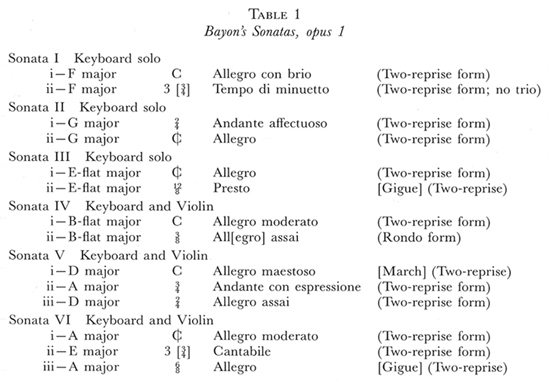
Her style, as can be expected from the preceding account of her pupil Angélique's keyboard repertoire, combines traditional French keyboard writing and German and Italian influences, producing music representative of the so-called international Classic style of the later decades of the eighteenth century. The first four sonatas—the three for solo keyboard and the first of the sonatas with violin accompaniment—are, like Alberti's sonatas, in two movements, both in the same key but with contrasting tempos and characters. The other two accompanied sonatas, like many sonatas of Eckard and Schobert, have three movements in the pattern fast-slow-fast; middle movements are in the dominant key. Except for Sonata IV/ii, a rondo, the movements are in the usual two-reprise form, that is, "sonata form," of the Classic era, with distinctive melodic material to mark the second key area of the first reprise and, in the second reprise, a recapitulation of opening material with the return to the home key. In the two-movement works no repeat marks are printed but they may be assumed—at double bars at the end of each reprise and at the end of the rondo's first couplet. There are several printing errors as well—occasional wrong notes, misplaced trills, and, most often, missing sharps or natural-signs with the modulation to the dominant in the first reprise.
The sonatas show the usual Classical variety of styles or, to use Leonard Ratner's term, musical "topics"30—marches (as in Sonata V/i), dances such as the minuet (I/ii) and gigue (the final movements of Sonatas III and VI), songs and opera arias (the "cantabile" of VI/ii), symphonies and overtures, and concertos. Example 1 shows the opening of Sonata I/i, an energetic study with almost continuous sixteenth-note accompaniment patterns; performance seems to require only "precision and a steady beat," a style that, as noted earlier, Angélique Diderot was to find atypical of Bayon.
Example 1: Sonata I/i, mm. 1-11
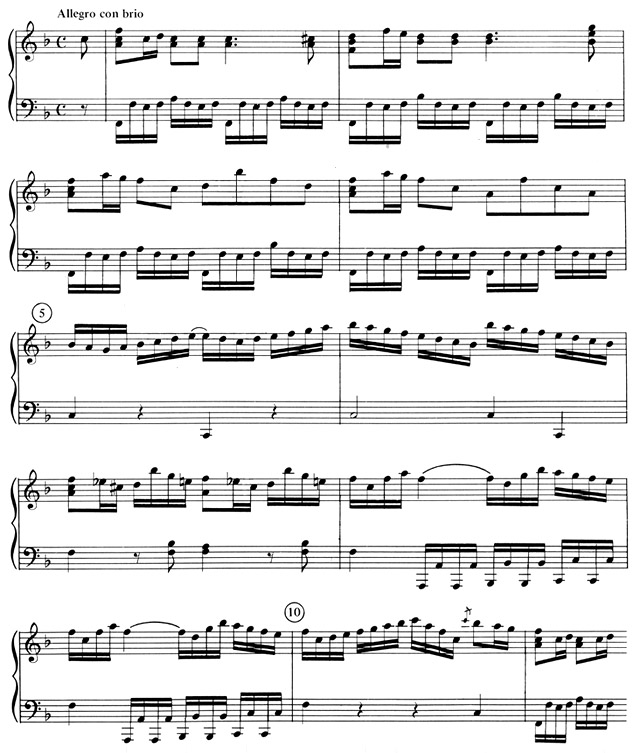
Other movements are more typically "delicate." The second movement of Sonata I begins in a melodically elegant and graceful manner, as shown in Example 2. A single-line left-hand accompanying part contributes to the sparse, Italianate texture. This movement, unlike the first movement, has occasional piano and forte markings. Left-hand notation in alto clef occurs here and in other sonatas in this set as well.
Example 2: Sonata I/ii, mm. 1-14
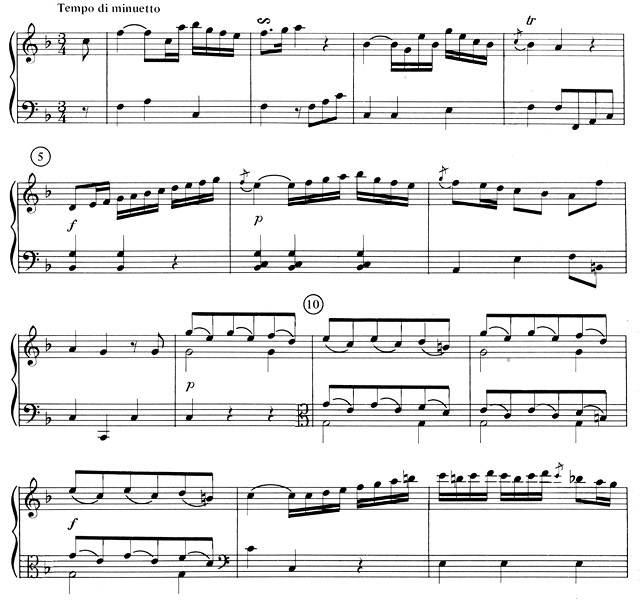
Example 3 is the opening of Sonata II/i, the only first movement not marked Allegro. Marked "Andante affectuoso," it is an expressive melody over Alberti bass and other accompaniment patterns.
Example 3: Sonata II/i, mm. 1-25
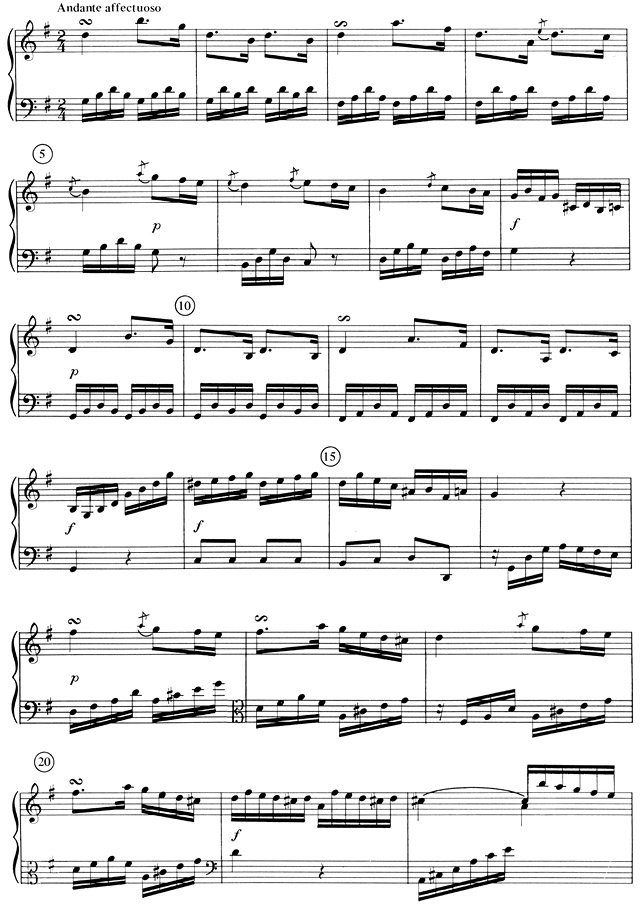
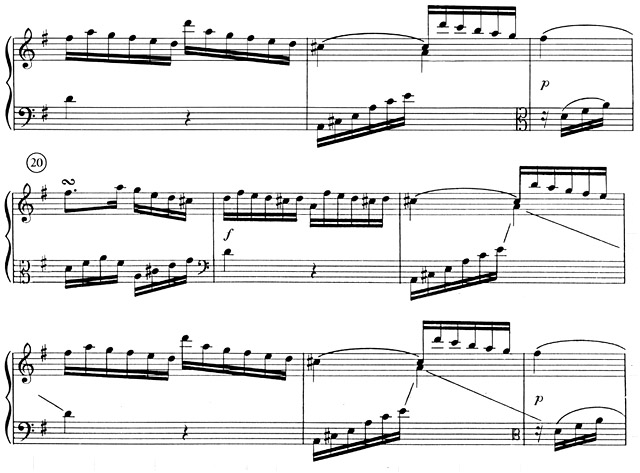
The phrasing is regular and gallant, in two- and four-measure groupings. The second phrase, beginning like the opening melody in measure 9, completes the period and gives this main idea added substance and seriousness. M. 17 moves to the dominant and subsequent phrases remain there to the close of the first reprise in m. 45, after repeated cadential motives.
Accompanied Sonatas
The three sonatas with violin accompaniment are generally of a more lyrical character than the solo sonatas, in keeping with the violin's ability to sustain tone. The violin is truly "obligatory" (obligé) as described on the title page, and there is a continuous exchange of musical ideas between the two players. Because the sonatas are published in score format the violinist is presumably meant to read over the shoulder of the keyboard player. Solo keyboard performance would be possible, but not as easy as in Schobert's Sonate en symphonie mentioned earlier, where accompanying instrumental parts can simply be omitted. In Bayon's accompanied sonatas a keyboard player performing alone would have to read all three staves and choose the two most important parts to play in each phrase.
In several passages the violin melody is set over only a figured bass, not an unusual scoring even at this late date.31 These passages occur in Sonata IV/i, Sonata V/i and iii, and Sonata VI/i and ii. Example 4 is the opening of Sonata VI/i.
Example 4: Sonata VI/i, mm. 1-17
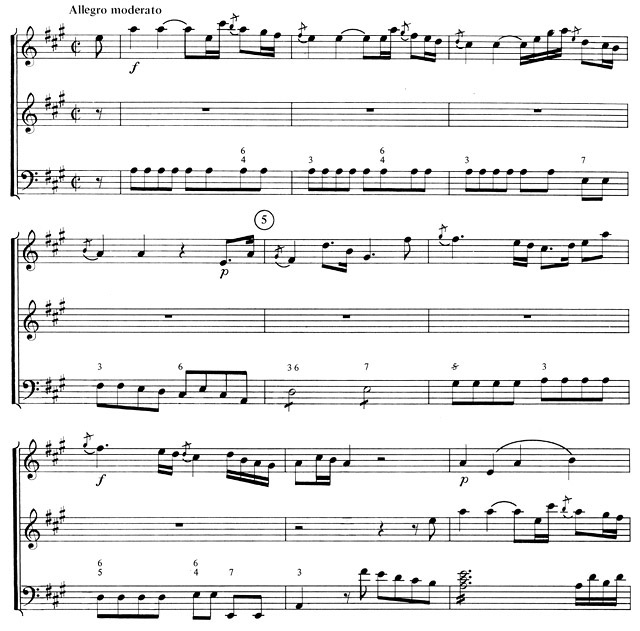
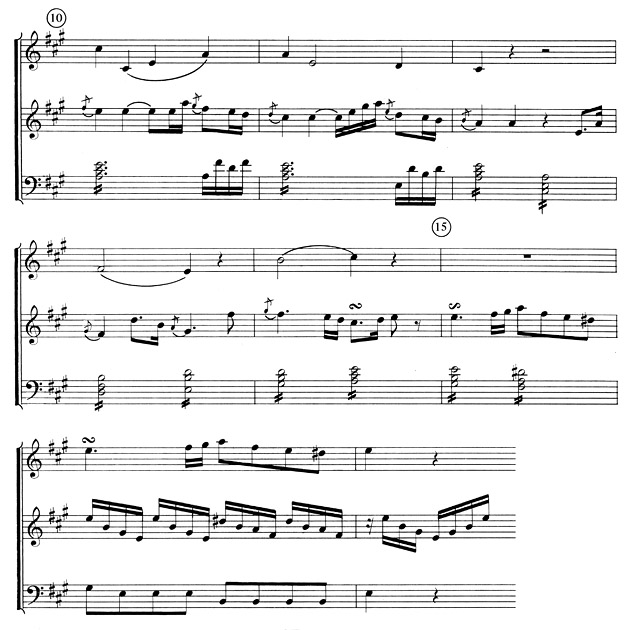
The violin first states the melody in mm. 1-8 with figured bass accompaniment; beginning in m. 9 the restatement is by right-hand keyboard with a fully notated left-hand and violin accompaniment. For realization the keyboard player can use the left-hand part of mm. 9-15 as a model. Example 5 shows a sample realization for these measures.
Example 5: Sample figured bass realization for Sonata VI/i, mm. 1-8
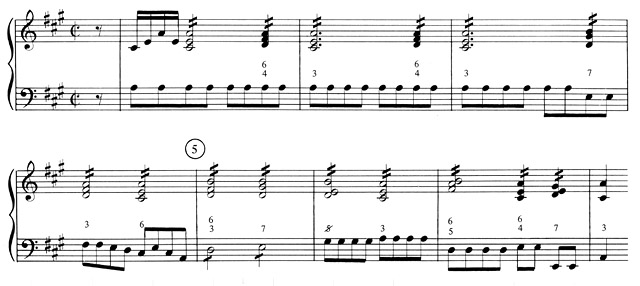
It is also acceptable to play the keyboard part as written, preserving the thin texture and subtle harmonic movement of the gallant style (as heard in the solo keyboard sonatas). On the other hand, the repetition of opening material in two different instrumentations in this accompanied sonata suggests an allusion to the tutti-solo contrast of the concerto format, where the keyboard plus violin is the tutti and the keyboard alone is the solo instrument; if performers choose to dramatize the similarities to concerto texture the pianist should play a full-voiced realization to create a fuller, not thinner, texture for the tutti than for the solo statement that follows. As this movement proceeds the two instruments alternate more frequently, as in the violin's repetition in m. 16 of the pianist's previous measure.
Sonata IV/i shows similar restatement of the opening idea except that the pianist begins and the violin, with figured bass, provides the restatement. A different arrangement occurs in Sonata V/i, shown in Example 6, where there is only one statement of the initial idea, mm. 1-11, by the violin with a fully written-out keyboard part, including half-measure answers in the right hand.
Example 6: Sonata V/i, mm. 1-17
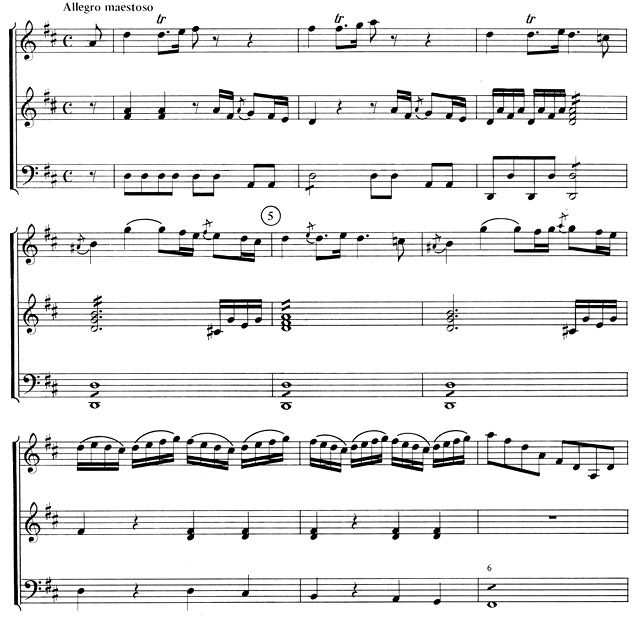
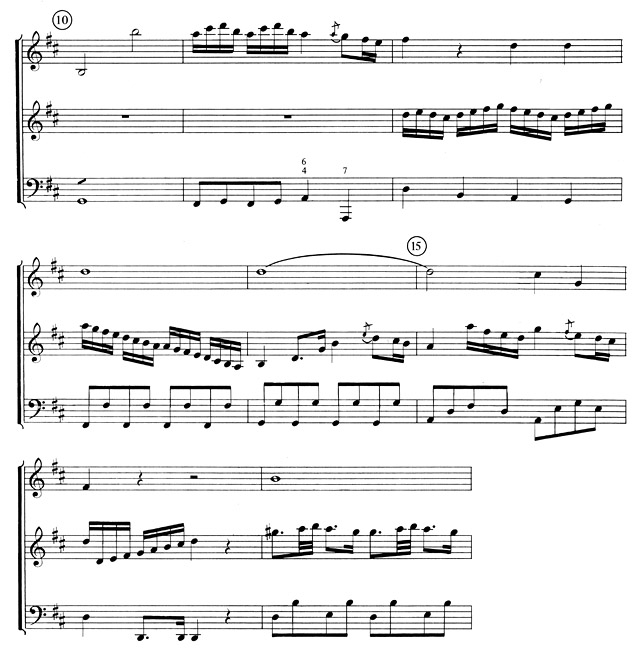
The virtuosic violin writing of this sonata, even more than the violin's independence in the other two accompanied sonatas, indicates that they were written for, and performed by, someone as skilled as the famous Cramer whom Madame de Genlis so admired, if not by Cramer himself. The keyboard continues the violin's bravura cadence, mm. 12-16, and then continues on to begin the dominant-key material. A sample realization for mm. 9-11 appears in Example 7.
Example 7: Sample figured bass realization for Sonata V/i, mm. 9-11

Fleur D' Épine
In the 1770s, during the early years of Madame Louis's marriage, her husband began working on the design and construction of the theatre in Bordeaux, the building that, more than any other, was to make him famous. In 1774 the couple's only child was born, a daughter named Marie-Hélène-Victoire Louis. (With the daughter's eventual marriage around 1790 the Louis family name fell into obscurity, making the biographer's work more difficult.)32
In August 1776 Madame Louis's Fleur d' épine was produced by the troupe at the Théâtre-Italien (one of the royal troupes), as noted above. (Fétis says August 19, the score's title page says August 22.) Like the sonatas, it had first been performed at a private gathering (according to Choron and Fayolle, quoted earlier). More information comes from literary critic Jean-François de La Harpe (1739-1803), who in a letter of 1776, when the work "has just been performed at the Italians," mentions a performance "several years earlier" in Saint-Germain on the stage of M. le duc de Noailles.33 A notice in the Correspondence secrète—news of the court and of Paris society—identifies the composer, "already famous for her musical talents under the name of Mlle Bayon," as the person "who brought into fashion the fortepiano, an instrument that is now all the rage."34 (This is apparently the source of the description quoted earlier from La grande Encyclopédie.)
A full orchestral score including dialogue was subsequently published (see note 2). Scoring is for violins 1 and 2, viola, "basso" (cello), two horns, two oboes, two flutes, and solo voices. The dedication is to Madame la Duchesse de Chartres—Madame de Genlis was governess to her children (one of whom was later King Louis-Philippe) and may have helped Madame Louis obtain this patronage. Madame Louis's preface is about half the length of her preface to the sonatas and has a more confident tone. While she speaks again of her "feeble talents" and her "gratitude" to her patron, she condenses any detailing of this patron's attributes into a graceful reference to a "princess," in which she implies a subtle comparison to the heroine of the opera ("her name at the head of my work is a glorious title"). The composer also points out that she, like her patron and the opera's heroine, is a woman. Of interest is her statement that her patron's name "assures me of the public's approval." This, like her reported wish to impress J.C. Bach's English friends (and thus Bach himself), would seem to demonstrate a desire for the attention of the musical public beyond her immediate circle.
This comédie is a two-act tale of love and magic. The twenty musical numbers—ten in each act—are mostly solo airs or "ariettes" as the title page specifies. The remainder are duets, trios, and ensemble numbers, including ensemble finales for each act. The music is in the tuneful Italian—or "international" style so much in favor with Diderot, Grimm, and most Paris critics. The overture has two sections likewise on the Italian plan, fast-slow (Allegro-Andante). Like Madame de Genlis, other writers comment unfavorably on the libretto by the abbé Claude-Henri de Voisenon (1708-1775); La Harpe calls it "cold." Further, contrary to the opinion of Madame de Genlis, La Harpe pronounces Madame Louis's music inadequate to revive the drama, although he says there are some "pleas-ant airs."
A lengthier report appears in the Correspondance littéraire for August 1776, a collection of literary and political news sent periodically from Paris to northern European courts; it had been begun by Diderot and Grimm, but by 1776 was being compiled by Grimm's secretary Hans (or Henri) Meister (1744-1826) in collaboration with Madame d'Épinay (1726-1783), salonnière and woman of letters. The writer finds "the only really nice scene" in the play to be one in which the heroine sings the Prince Dentillon to sleep and then converses with an "echo"; in the Correspondance littéraire this conversation is quoted in full.35 Fétis quotes a similar report from the Annales du Théâtre-Italien for 1776, which singles out as the most striking moments of true beauty "a trio in dialogue, a sleep air, and a grand air d' exécution."
For members of the musical public with no orchestra at their disposal, several publishers produced arrangements of the music for small ensemble (see note 2). One was an arrangement of the orchestral overture for keyboard with violin and violoncello accompaniment "ad Libitum" by "M. Bénaut, Maître de Clavecin de l' Abbaye Royale de Montmartre, Dames de la Croix, etc." and published by the arranger; the Bibliothèque Nationale has only the keyboard and violoncello ("basso") parts. Another was the collection of Ariettes de la Fleur d' épine, Opéra Comique published by Mlle Girard in Paris; a copy is now in the municipal library in Versailles. (Contrary to Fétis's description, however, there is no piano accompaniment.) Huguet also published the same songs (but re-engraved), likewise for solo voices without accompaniment, titled Airs détachés de Fleur d' épine; a copy is in the Bibliothèque Nationale. One of the airs, "On ne doit compter," was also published in collections in various versions for accompanied voices.36
The Louis Salon
Towards the end of 1776 Madame Louis joined her husband in Bordeaux, where her musical activities apparently continued. The Louis residence opposite the new theatre became the site of a highly select salon. Madame Louis was described as "a woman of boundless wit and great beauty" whose "attractive charm and amiability" made the city's smart set eager to attend regularly.37 The only known portrait of her dates from this time; its painter, an artist who worked with her husband on the theatre's interior design, posed her playing music and he exhibited the portrait in Paris.38 From the Bordeaux years there is also a reference to performances of two "operas" by Madame Louis, not at the Bordeaux theatre but probably at her salon, possibly at another season.39
With the completion of the Bordeaux theatre in 1780 the family returned to Paris. Besides seeing the publication of Fleur d' épine in its several arrangements, she also—because of her husband's position and perhaps to enhance his career and social standing—continued in her roles of salonnière and patron of musicians and other artists. Her husband's biographer quotes later references to the distinguished company of literary and artistic figures at the "sought after" Louis salon.40 She undoubtedly continued to perform regularly, and she probably continued to compose at least for her salon.
A distinguished social historian recently noted that, "For all the prominence of salons in stories of eighteenth-century France, we know remarkably little about what happened in them and their meaning in the lives of their participants."41 This is true in the case of Madame Louis. We must surmise from what little evidence is available that the salon became her principal, perhaps only, opportunity for performance. Beyond that, as evidence of her musical style and her particular interests we have only her earlier published music and reports by musical friends and literary critics. If we had her memoirs or letters, or even reports by any other trained musician who performed with her, we would stand on firmer ground.
Musical Influence
Madame Louis's published music was known outside France. The Opus 1 sonatas brought her some of the recognition Diderot thought she was seeking in England: the copy of her sonatas now in the British Library is inscribed "This Volume belongs to the Queen 1788" (Queen Charlotte, wife of George III). The connection may be J.C. Bach, perhaps through Cramer, who had left Paris for London in 1772 and worked with him. Inclusion of the sonatas in the Breitkopf thematic catalog initiated recognition of her by German music scholars, beginning with the inclusion of her name in Sulzer's encyclopedia. Copies of the Fleur d' épine score found their way from Paris to the Berlin Staatsbibliothek, the Fürstlich Öttingen-Wallerstein'sche Bibliothek in Harburg, and the Österreichische Nationalbibliothek in Vienna, accounting for Eitner's bibliographic coverage of her music, as noted earlier (see n. 7). Copies are also in the British Library and the Library of Congress.
There are no reports that she ever traveled outside France, whether on concert tours or for any other reason. Although Fétis believed that she left France, following her husband, at the 1789 Revolution, her husband's biographer later published evidence that Louis continued to work in Paris—as "citizen Louis"—and died there in 1800.42 He had retired with his family to a country residence at the abbey Chartreuse de Gaillon, not far from Paris. (He had been contemplating a trip to America, but told a friend he had not yet consulted his wife.43) A poem written in 1797 in tribute to Madame Louis by novelist and dramatist Jean-François Marmontel (1723-1799), who lived on a small neighboring farm, was later discovered and published with Grimm's correspondence.44
After her husband's death there is a reference to her in the Almanach des Spectacles for 1801 that could mean that she was living and working in Paris.45 She died at Aubevoye, canton of Gaillon, department of Eure (near the family's country residence) on March 19, 1825.46
Conclusions
Investigation into the life and works of this composer is inseparable from consideration of the musical institutions and social environment in which she produced her music. As a musician she shared the tastes and musical values of her time. Her contacts and repertoire were international. Her name was associated with the development of fortepiano music and fortepiano playing. She also participated in another favorite French musical genre in the latter half of the eighteenth century, opéra comique, and was rewarded with a noteworthy public performance. Her activity, however, centered on private music making, mainly in the salon. Information is not as abundant about music in this sphere as it is about public concerts and theatrical productions.
It is clear from the foregoing accounts that "salon music" for the salons in France at this time, far from being of inferior quality and lesser importance, was music intended for the select few. It was performed by leading artists for listeners whose education and experience had led them to regard music as among the means of achieving a civilized society and personal happiness. Mademoiselle Bayon, later Madame Louis, made major contributions to musical life and to the important social and cultural institutions of her age.
1The Six sonates are item B1433 in Karlheintz Schlager, Einzeldrucke vor 1800, ser. A of Repertoire internationale des sources musicales (RISM) (London, 1971-1981), vol. 1, p. 240. The date of 1769 seems likely because the sonatas "Opera 1" of "Sigra. Bayon," published in Paris, are listed in the Breitkopf Thematic Catalogue, Supplement IV, of 1769. While it is possible that Breitkopf received advance copies of the incipits, it is more likely that the sonatas were published by 1769 or even earlier. See The Breitkopf Thematic Catalogues, ed. Barry S. Brook (New York, 1966), p. 363 (three solo "cembalo" sonatas) and p. 364 (three "trios" for violin and cembalo). A facsimile edition of the sonatas has been published, edited with introduction by D. Hayes (New York: Da Capa Press, 1990).
2RISM, ser. A, B1428 and B1429, are full scores published by Huguet and Houbard, respectively. B1430 is an arrangement of the overture for keyboard with violin and violoncello accompaniment "ad Libitum," and B1431 and B1432 are collections of airs and ariettes from Fleur d' épine.
3Johann Georg Sulzer, "Sonate," Allgemeine Theorie der schönen Künste (1771-1774), 2d ed., rpt. Hildesheim (1967), vol. 4, p. 426. "Mde [sic] Louis" is among the names of 190 composers of sonatas at the end of the article "Sonate."
4Ernst Ludwig Gerber, Historisch-Biographisches Lexikon der Tonkünstler (1790-1792) und Neues historisch-Biographisches Lexikon der Tonkünstler (1812-1914), ed. Othmar Wesseley (Graz, Austria, 1977), vol.1, col. 121 (Bayon) and col. 824 (Louis), and vol. 3, p. 262. Under "Bayon" Gerber dates the publication of her sonatas as 1770, as do most writers, but under "Louis" he dates them 1784probably an error, or else, less likely, he refers to a later, probably German edition no longer extant. In the Neues Lexikon Gerber describes Madame Louis as "perhaps a Paris amateur" (Dilettantin) and dates the published music, "1795 or 1796" (again, probably an error).
5Alexandre E. Choron et F.J.M. Fayolle, Dictionnaire historique des musiciens, vol. 1 (Paris, 1810), p. 57 (Bayon) and p. 429 (Louis). This work, like Gerber's first Lexikon, dates the sonatas 1770, and notes that Fleur d' épine, composed for private performance, was judged worthy of production at the Opéra Comique. (Opéra Comique is the new name adopted in 1790 for what was called in 1776 the Théâtre-italien, itself an amalgamation of the Comédie Italienne and Théâtre de la Foire St.-Germain.)
6François Fétis, "Louis (Mme)," Biographie universelle des musiciens, 2d ed. (Paris, 1863), vol. 5, p. 23. Fétis repeats the information found in Choron and Fayolle, and quotes from the Annales du Théâtre-Italien for 1776 concerning Fleur d' épine. He also speculates that Madame Louis left Paris during the Revolution (she probably did not), and that she might have written two treatises on keyboard fingering and accompaniment found in Vienna in 1799 and signed "Louis (Ph.)." Fétis and RISM are the principal sources for Susan Stern, Women Composers: A Handbook (Metuchen, N.J., 1978), p. 41 (Bayon-Louis) and p. 112 (Louis).
7Robert Eitner, Biographisch-bibliographisches Quellen-Lexikon der Musiker und Musikgelehrten (Leipzig, 1898-1904), vol. 1, p. 390 (Bayon) and vol. 6, p. 229 (Louis). Eitner repeats Gerber's information on Bayon and on Louis, citing his source, and adds library locations of her published music.
8"Bayon," Larousse de la musique, ed. Norbert Dufourcq (Paris, 1957), vol. 1, p. 85, is identified as an eighteenth-century French harpsichordist, singer, and composer. Works mentioned are the sonatas "published in 1770, the same year as her marriage to the famous architect Louis," one collection of ariettes, and one opéra-comique Fleur d' épine.
9La grande Encyclopédie: Inventaire raisonné des sciences, des lettres et des arts (Paris: 1886-1902), vol. 22, p. 668. The paragraph, unsigned, follows the article "Louis (Louis-Victor-Nicolas)" by Ch. Lucas. The date of "around 1780" is offered for the sonatas (probably at least ten years too late), and a Recueil d' ariettes and Fleur d' épine are mentioned as her compositions.
10Charles Marionneau, Victor Louis (Bordeaux, 1881), p. 554, n. 1. Similarly, John Towers, Dictionary-Catalogue of Operas (Morgantown, W. Va., [1910]), p. 264, offers "1746?". Several sources give 1753 as the year of her birth: Dénis Diderot, Correspondance, ed. Georges Roth and Jean Varloot (Paris, 1955-1970); Jean Gribenski, "Àpropos des Leçons de clavecin (1771): Diderot et Bemetzrieder," Revue de musicologie, 66 (1980), p. 132, n. 22; and Jean Mayer and Pierre Citron, eds., Diderot et la musique, vol. 19 of Diderot, Oeuvres complètes (Paris, 1983), pp. ix-xxii.
11Madame Stéphanie-Félicité de Genlis (1746-1830), Mémoires inédites de Mme la comtesse de Genlis (Paris, 1825), vol. 1, p. 357, quoted by Marionneau, Victor Louis, pp. 95-96. All translations in this article are by the author.
12Diderot, Correspondance, vol. 8, pp. 93-94, to Sophie Volland, 24 August 1768.
13Ibid., p. 152, to Sophie Volland, 10 September 1768.
14Arthur M. Wilson, Diderot (New York, 1972), p. 842, n. 9.
15Diderot, Correspondance, vol. 10, p. 79, to Grimm, 30 June 1770.
16Ibid., pp. 87-88, to M. and Mme Victor Louis, no date.
17Ibid., p. 157, to Sophie Volland, 2 November 1770.
18Diderot, Leçons, in Oeuvres complètes, vol. 19, p. 162.
19Ibid.
20Ibid., p. 194.
21Ibid., p. 175.
22Ibid., p. 159.
23Ibid., p. 175.
24Ibid., pp. 61-62. The score is in Das Erbe deutscher Musik, Sonderreihe, vol. 4, ed. Gustav Becking (Kassel, 1960), pp. 23-27, titled Symphonie.
25Diderot, Leçons, pp. 193.
26Ibid., p. 209.
27Ibid.
28Eckard's Avertissement for the Opus 1 sonatas (1763) is quoted by William Newman, The Sonata in the Classic Era, 2d ed. (New York, 1972), pp. 634-35: "I have tried to make this work equally appropriate to the harpsichord, clavichord, and piano. It is for this reason that I have felt obliged to mark the softs and louds so often, which [editing] would have been useless if I had only the harpsichord in mind."
29Michel Brenet, Les Concerts en France sous l'Ancien Régime (1900; reprint, New York, 1970), p. 292.
30Leonard G. Ratner, Classic Music: Expression, Form, and Style (New York, 1980).
31Cf. David Fuller, "Accompanied Keyboard Music," The Musical Quarterly, vol. 60 (1974), p. 225: "In 1770, Armand-Louis Couperin was still using figured bass for purely accompanimental passages in a movement—as gallant as you please—otherwise dominated by the keyboard part."
32Marionneau, Victor Louis, p. 554, n. 1. Mlle Louis married M. Charles-Marie-Nicolas-Aimé Éthis de Corny.
33La Harpe, Correspondance littéraire, vol. 1 (Geneva, 1968), p. 332.
34Correspondance secrète, politique et littéraire, ou Memoire pour servir à l' histoire des Cours, des Sociétés et de la littérature en France, depuis la mort de Louis XV, ed. Métra and others (London, 1787), quoted in Marionneau, Victor Louis, p. 101).
35Correspondance littéraire, philosophique. et critique par Grimm, Diderot, Raynal, Meister, etc., ed. Jules Taschereau, vol. 9 (Paris 1830), pp. 178-79 (for August 1776); new ed. by Maurice Torneux, vol. 11 (Paris, 1879), pp. 324-36.
36Julie Anne Sadie, "Musiciennes of the Ancien Régime," in Women Making Music, ed. Jane Bowers and Judith Tick (Urbana and Chicago, 1986), p. 213.
37Gailleur l'Hardy, Portefeuille iconographique de V. Louis (Paris, 1828), p. 322, quoted by Marionneau, Victor Louis, p. 99.
38Marionneau, Victor Louis, p. 99. The artist's name was Jean-Baptiste Robin.
39Ibid., p. 99-100.
40Ibid., p. 554.
41Carolyn Lougee, review of French Women and the Age of Enlightenment, ed. Samia I. Spencer, Eighteenth-Century Studies, vol. 20 (1987), p. 370.
42Marionneau, Victor Louis, pp. 97-98 and 526-27.
43Ibid., p. 348.
44Ibid., p. xi. Marionneau quotes the poem in full.
45Ibid., p. 100.
46Ibid., p. 555, n. 2.
